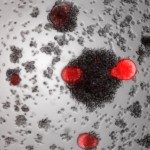Link to Pubmed [PMID] – 29996094
Link to DOI – 10.1016/j.celrep.2018.06.047
Cell Rep 2018 Jul; 24(2): 320-328
The flavivirus genus comprises major human pathogens, such as Dengue (DENV) and Zika (ZIKV) viruses. RIG-I and MDA5 are key cytoplasmic pathogen recognition receptors that are implicated in detecting viral RNAs. Here, we show that RNAs that co-purified with RIG-I during DENV infection are immuno-stimulatory, whereas RNAs bound to MDA5 are not. An affinity purification method combined with next-generation sequencing (NGS) revealed that the 5′ region of the DENV genome is recognized by RIG-I. No DENV RNA was bound to MDA5. In vitro production of fragments of the DENV genome confirmed the NGS data and revealed that the 5′ end of the genome, when bearing 5′-triphosphates, is the RIG-I ligand. The 5′ region of the ZIKV genome is also a RIG-I agonist. We propose that RIG-I binds to the highly structured and conserved 5′ region of flavivirus nascent transcripts before capping and that this mechanism leads to interferon secretion by infected cells.



